Research Report: Technology Advancements in Oncology Healthcare
VerifiedAdded on 2023/01/11
|20
|4290
|23
Report
AI Summary
This report examines the advancements in technology within the oncology sector, focusing on the Nexus Ultrasonic Surgical Platform. The study reviews existing literature, outlines the methodology including constructivism, phenomenology research, and data collection through questionnaires targeting young parents. Data analysis involves regression and correlation to assess the impact of technology on healthcare, particularly in child oncology. The research aims to understand the role of emerging technologies, suggest practical ways to introduce innovation, and contribute to the field by analyzing data from surveys with oncology area workers, and secondary sources. The report discusses the factors affecting technological advancements, existing methodologies, and the theoretical framework, concluding with key findings and implications for healthcare policy and practice.
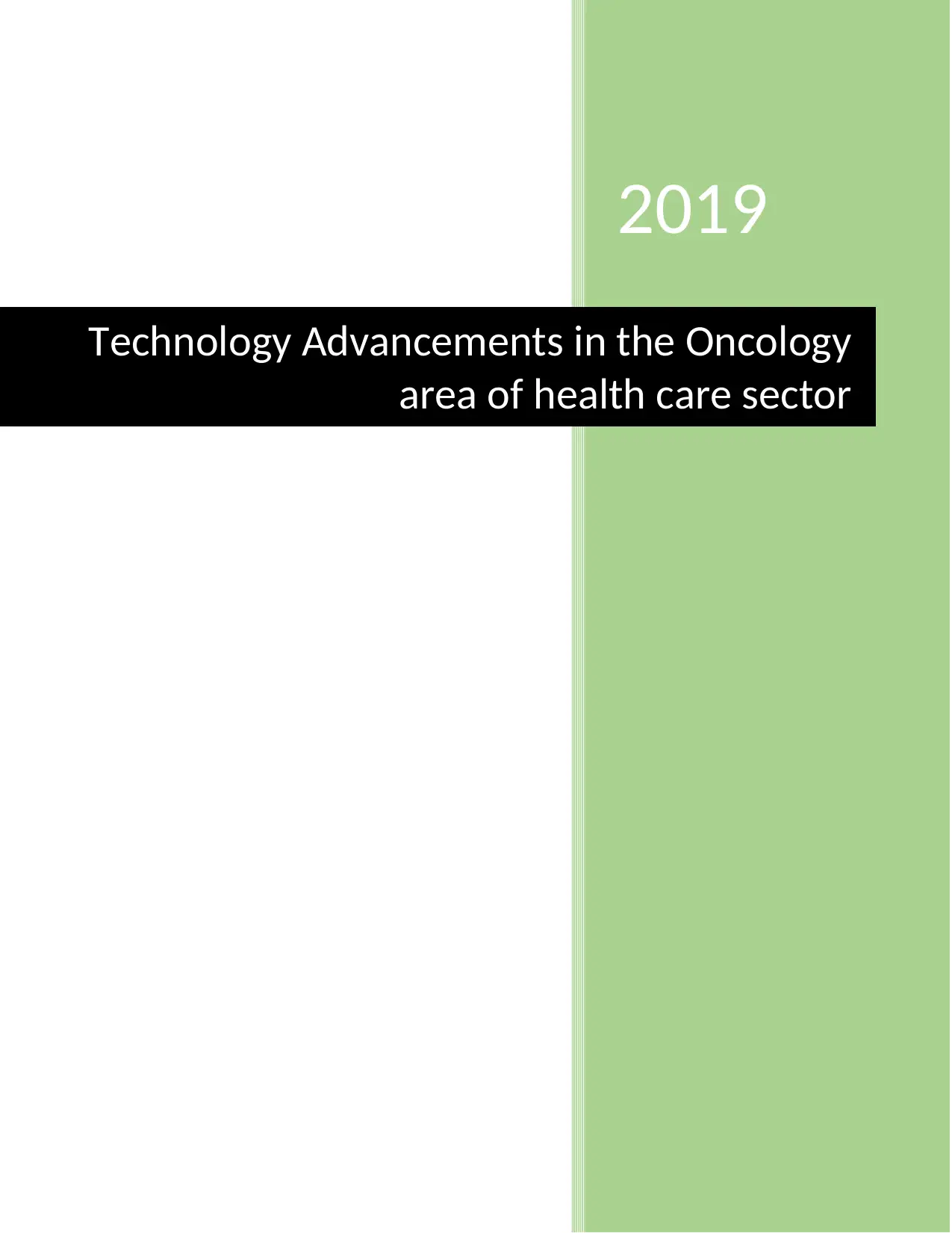
2019
Technology Advancements in the Oncology
area of health care sector
Technology Advancements in the Oncology
area of health care sector
Paraphrase This Document
Need a fresh take? Get an instant paraphrase of this document with our AI Paraphraser
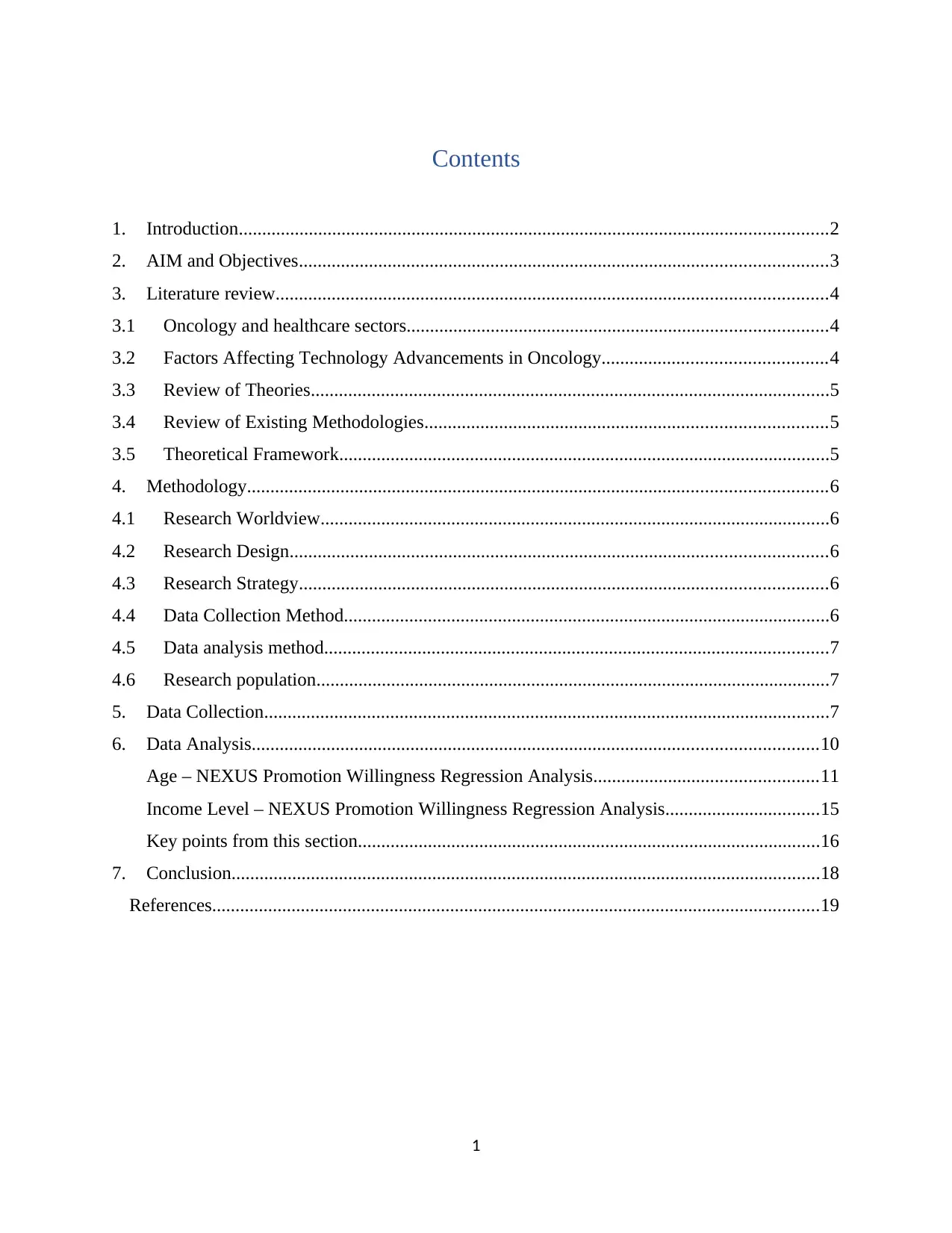
Contents
1. Introduction..............................................................................................................................2
2. AIM and Objectives.................................................................................................................3
3. Literature review......................................................................................................................4
3.1 Oncology and healthcare sectors..........................................................................................4
3.2 Factors Affecting Technology Advancements in Oncology................................................4
3.3 Review of Theories...............................................................................................................5
3.4 Review of Existing Methodologies......................................................................................5
3.5 Theoretical Framework.........................................................................................................5
4. Methodology............................................................................................................................6
4.1 Research Worldview.............................................................................................................6
4.2 Research Design...................................................................................................................6
4.3 Research Strategy.................................................................................................................6
4.4 Data Collection Method........................................................................................................6
4.5 Data analysis method............................................................................................................7
4.6 Research population..............................................................................................................7
5. Data Collection.........................................................................................................................7
6. Data Analysis.........................................................................................................................10
Age – NEXUS Promotion Willingness Regression Analysis................................................11
Income Level – NEXUS Promotion Willingness Regression Analysis.................................15
Key points from this section...................................................................................................16
7. Conclusion..............................................................................................................................18
References..................................................................................................................................19
1
1. Introduction..............................................................................................................................2
2. AIM and Objectives.................................................................................................................3
3. Literature review......................................................................................................................4
3.1 Oncology and healthcare sectors..........................................................................................4
3.2 Factors Affecting Technology Advancements in Oncology................................................4
3.3 Review of Theories...............................................................................................................5
3.4 Review of Existing Methodologies......................................................................................5
3.5 Theoretical Framework.........................................................................................................5
4. Methodology............................................................................................................................6
4.1 Research Worldview.............................................................................................................6
4.2 Research Design...................................................................................................................6
4.3 Research Strategy.................................................................................................................6
4.4 Data Collection Method........................................................................................................6
4.5 Data analysis method............................................................................................................7
4.6 Research population..............................................................................................................7
5. Data Collection.........................................................................................................................7
6. Data Analysis.........................................................................................................................10
Age – NEXUS Promotion Willingness Regression Analysis................................................11
Income Level – NEXUS Promotion Willingness Regression Analysis.................................15
Key points from this section...................................................................................................16
7. Conclusion..............................................................................................................................18
References..................................................................................................................................19
1
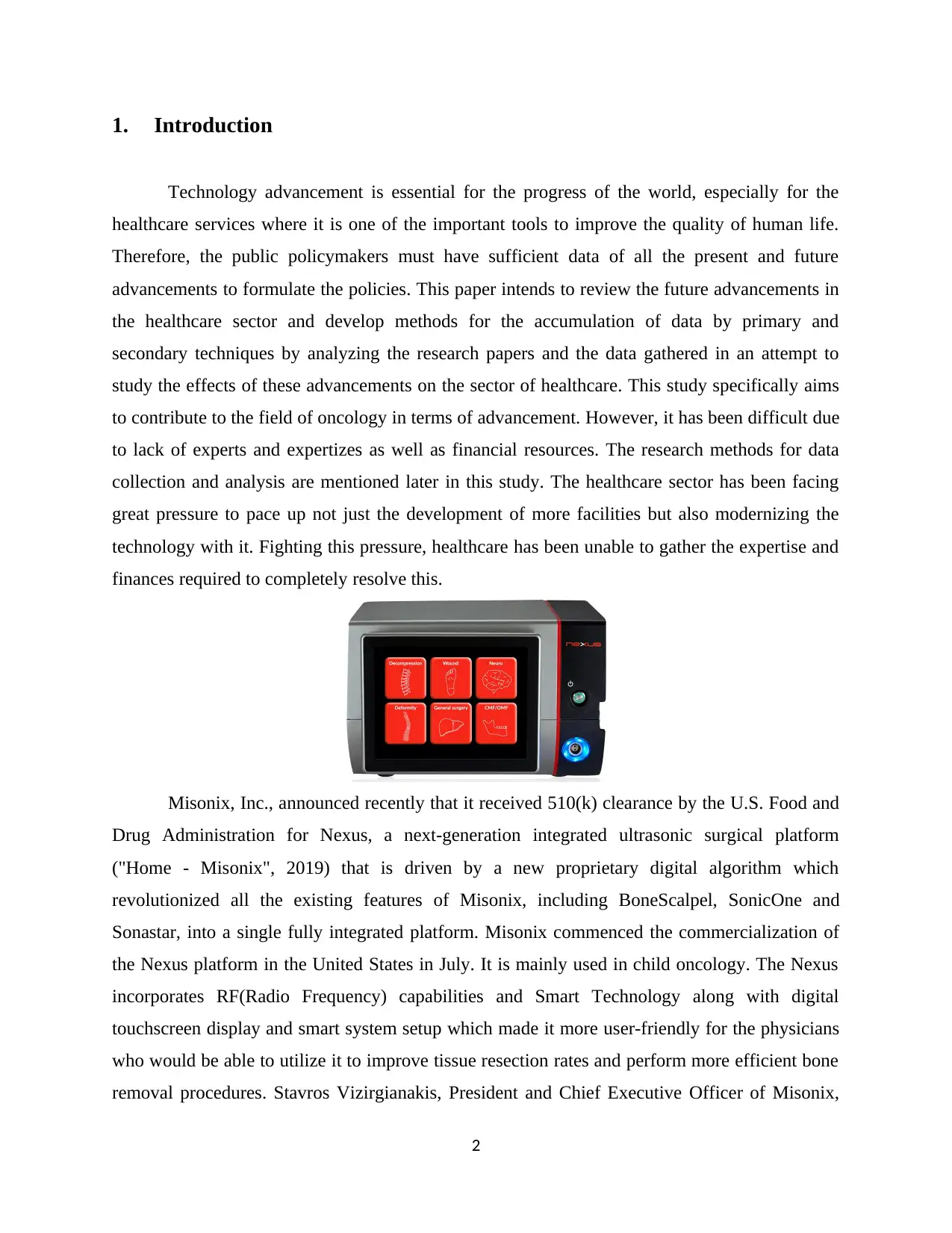
1. Introduction
Technology advancement is essential for the progress of the world, especially for the
healthcare services where it is one of the important tools to improve the quality of human life.
Therefore, the public policymakers must have sufficient data of all the present and future
advancements to formulate the policies. This paper intends to review the future advancements in
the healthcare sector and develop methods for the accumulation of data by primary and
secondary techniques by analyzing the research papers and the data gathered in an attempt to
study the effects of these advancements on the sector of healthcare. This study specifically aims
to contribute to the field of oncology in terms of advancement. However, it has been difficult due
to lack of experts and expertizes as well as financial resources. The research methods for data
collection and analysis are mentioned later in this study. The healthcare sector has been facing
great pressure to pace up not just the development of more facilities but also modernizing the
technology with it. Fighting this pressure, healthcare has been unable to gather the expertise and
finances required to completely resolve this.
Misonix, Inc., announced recently that it received 510(k) clearance by the U.S. Food and
Drug Administration for Nexus, a next-generation integrated ultrasonic surgical platform
("Home - Misonix", 2019) that is driven by a new proprietary digital algorithm which
revolutionized all the existing features of Misonix, including BoneScalpel, SonicOne and
Sonastar, into a single fully integrated platform. Misonix commenced the commercialization of
the Nexus platform in the United States in July. It is mainly used in child oncology. The Nexus
incorporates RF(Radio Frequency) capabilities and Smart Technology along with digital
touchscreen display and smart system setup which made it more user-friendly for the physicians
who would be able to utilize it to improve tissue resection rates and perform more efficient bone
removal procedures. Stavros Vizirgianakis, President and Chief Executive Officer of Misonix,
2
Technology advancement is essential for the progress of the world, especially for the
healthcare services where it is one of the important tools to improve the quality of human life.
Therefore, the public policymakers must have sufficient data of all the present and future
advancements to formulate the policies. This paper intends to review the future advancements in
the healthcare sector and develop methods for the accumulation of data by primary and
secondary techniques by analyzing the research papers and the data gathered in an attempt to
study the effects of these advancements on the sector of healthcare. This study specifically aims
to contribute to the field of oncology in terms of advancement. However, it has been difficult due
to lack of experts and expertizes as well as financial resources. The research methods for data
collection and analysis are mentioned later in this study. The healthcare sector has been facing
great pressure to pace up not just the development of more facilities but also modernizing the
technology with it. Fighting this pressure, healthcare has been unable to gather the expertise and
finances required to completely resolve this.
Misonix, Inc., announced recently that it received 510(k) clearance by the U.S. Food and
Drug Administration for Nexus, a next-generation integrated ultrasonic surgical platform
("Home - Misonix", 2019) that is driven by a new proprietary digital algorithm which
revolutionized all the existing features of Misonix, including BoneScalpel, SonicOne and
Sonastar, into a single fully integrated platform. Misonix commenced the commercialization of
the Nexus platform in the United States in July. It is mainly used in child oncology. The Nexus
incorporates RF(Radio Frequency) capabilities and Smart Technology along with digital
touchscreen display and smart system setup which made it more user-friendly for the physicians
who would be able to utilize it to improve tissue resection rates and perform more efficient bone
removal procedures. Stavros Vizirgianakis, President and Chief Executive Officer of Misonix,
2
⊘ This is a preview!⊘
Do you want full access?
Subscribe today to unlock all pages.

Trusted by 1+ million students worldwide
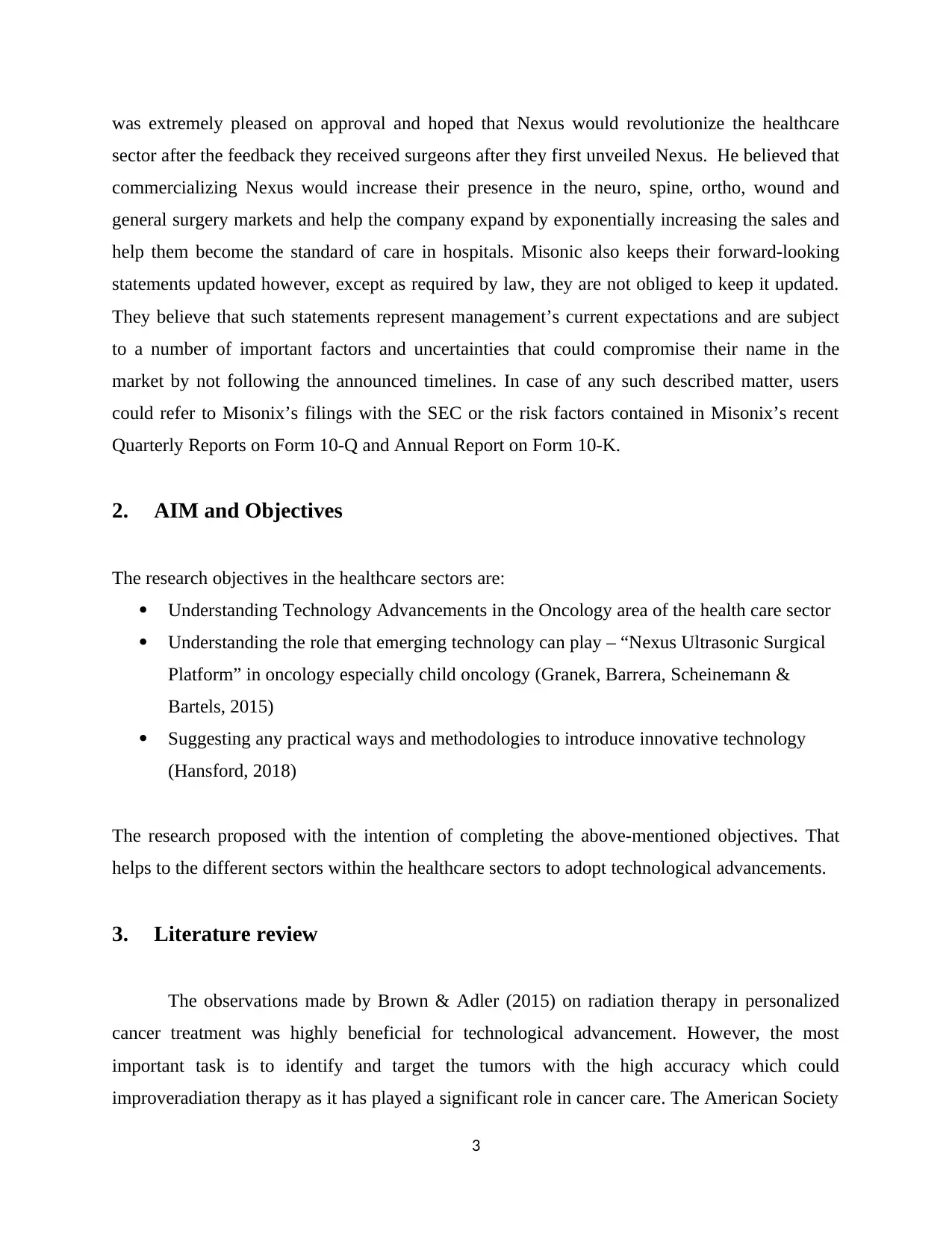
was extremely pleased on approval and hoped that Nexus would revolutionize the healthcare
sector after the feedback they received surgeons after they first unveiled Nexus. He believed that
commercializing Nexus would increase their presence in the neuro, spine, ortho, wound and
general surgery markets and help the company expand by exponentially increasing the sales and
help them become the standard of care in hospitals. Misonic also keeps their forward-looking
statements updated however, except as required by law, they are not obliged to keep it updated.
They believe that such statements represent management’s current expectations and are subject
to a number of important factors and uncertainties that could compromise their name in the
market by not following the announced timelines. In case of any such described matter, users
could refer to Misonix’s filings with the SEC or the risk factors contained in Misonix’s recent
Quarterly Reports on Form 10-Q and Annual Report on Form 10-K.
2. AIM and Objectives
The research objectives in the healthcare sectors are:
Understanding Technology Advancements in the Oncology area of the health care sector
Understanding the role that emerging technology can play – “Nexus Ultrasonic Surgical
Platform” in oncology especially child oncology (Granek, Barrera, Scheinemann &
Bartels, 2015)
Suggesting any practical ways and methodologies to introduce innovative technology
(Hansford, 2018)
The research proposed with the intention of completing the above-mentioned objectives. That
helps to the different sectors within the healthcare sectors to adopt technological advancements.
3. Literature review
The observations made by Brown & Adler (2015) on radiation therapy in personalized
cancer treatment was highly beneficial for technological advancement. However, the most
important task is to identify and target the tumors with the high accuracy which could
improveradiation therapy as it has played a significant role in cancer care. The American Society
3
sector after the feedback they received surgeons after they first unveiled Nexus. He believed that
commercializing Nexus would increase their presence in the neuro, spine, ortho, wound and
general surgery markets and help the company expand by exponentially increasing the sales and
help them become the standard of care in hospitals. Misonic also keeps their forward-looking
statements updated however, except as required by law, they are not obliged to keep it updated.
They believe that such statements represent management’s current expectations and are subject
to a number of important factors and uncertainties that could compromise their name in the
market by not following the announced timelines. In case of any such described matter, users
could refer to Misonix’s filings with the SEC or the risk factors contained in Misonix’s recent
Quarterly Reports on Form 10-Q and Annual Report on Form 10-K.
2. AIM and Objectives
The research objectives in the healthcare sectors are:
Understanding Technology Advancements in the Oncology area of the health care sector
Understanding the role that emerging technology can play – “Nexus Ultrasonic Surgical
Platform” in oncology especially child oncology (Granek, Barrera, Scheinemann &
Bartels, 2015)
Suggesting any practical ways and methodologies to introduce innovative technology
(Hansford, 2018)
The research proposed with the intention of completing the above-mentioned objectives. That
helps to the different sectors within the healthcare sectors to adopt technological advancements.
3. Literature review
The observations made by Brown & Adler (2015) on radiation therapy in personalized
cancer treatment was highly beneficial for technological advancement. However, the most
important task is to identify and target the tumors with the high accuracy which could
improveradiation therapy as it has played a significant role in cancer care. The American Society
3
Paraphrase This Document
Need a fresh take? Get an instant paraphrase of this document with our AI Paraphraser
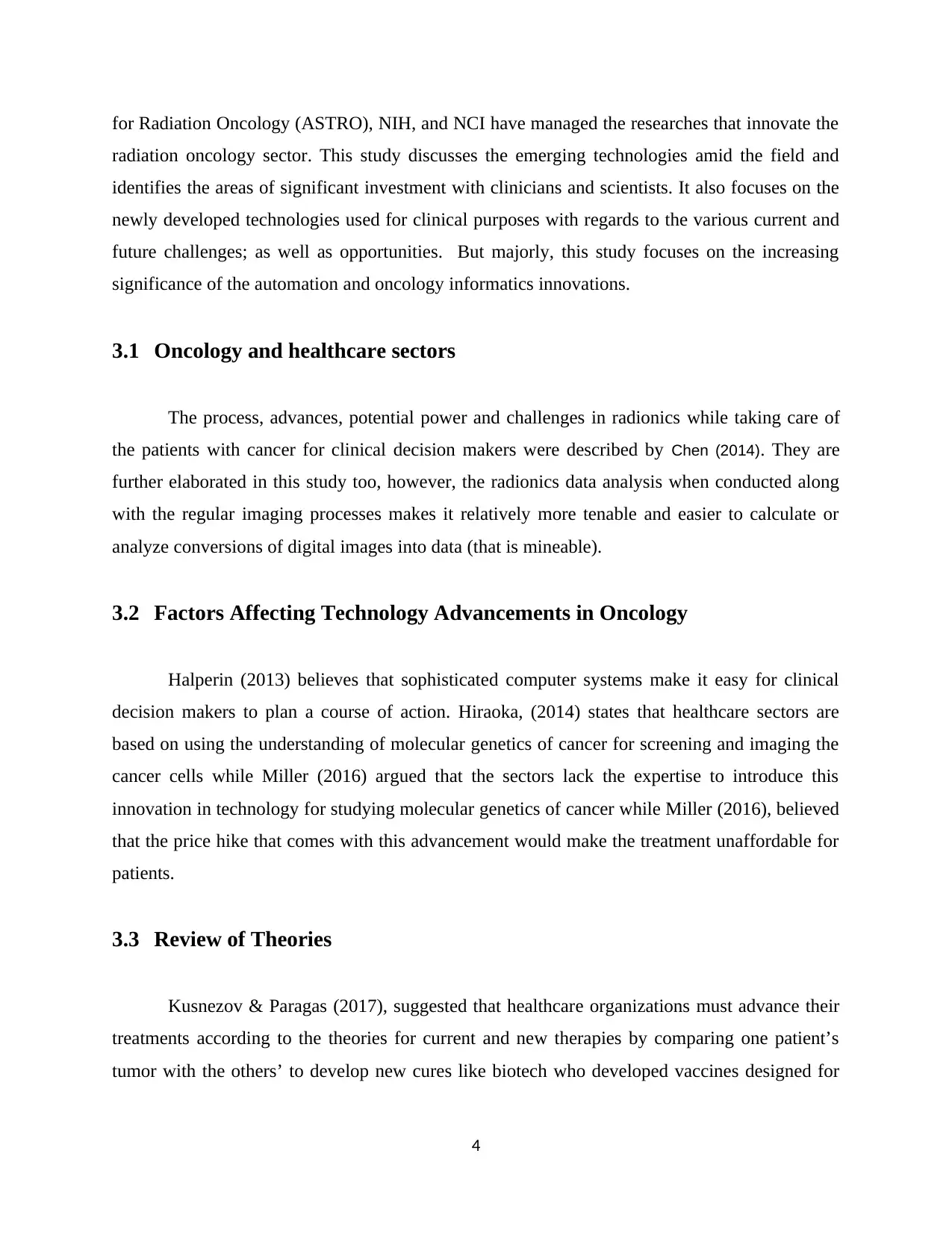
for Radiation Oncology (ASTRO), NIH, and NCI have managed the researches that innovate the
radiation oncology sector. This study discusses the emerging technologies amid the field and
identifies the areas of significant investment with clinicians and scientists. It also focuses on the
newly developed technologies used for clinical purposes with regards to the various current and
future challenges; as well as opportunities. But majorly, this study focuses on the increasing
significance of the automation and oncology informatics innovations.
3.1 Oncology and healthcare sectors
The process, advances, potential power and challenges in radionics while taking care of
the patients with cancer for clinical decision makers were described by Chen (2014). They are
further elaborated in this study too, however, the radionics data analysis when conducted along
with the regular imaging processes makes it relatively more tenable and easier to calculate or
analyze conversions of digital images into data (that is mineable).
3.2 Factors Affecting Technology Advancements in Oncology
Halperin (2013) believes that sophisticated computer systems make it easy for clinical
decision makers to plan a course of action. Hiraoka, (2014) states that healthcare sectors are
based on using the understanding of molecular genetics of cancer for screening and imaging the
cancer cells while Miller (2016) argued that the sectors lack the expertise to introduce this
innovation in technology for studying molecular genetics of cancer while Miller (2016), believed
that the price hike that comes with this advancement would make the treatment unaffordable for
patients.
3.3 Review of Theories
Kusnezov & Paragas (2017), suggested that healthcare organizations must advance their
treatments according to the theories for current and new therapies by comparing one patient’s
tumor with the others’ to develop new cures like biotech who developed vaccines designed for
4
radiation oncology sector. This study discusses the emerging technologies amid the field and
identifies the areas of significant investment with clinicians and scientists. It also focuses on the
newly developed technologies used for clinical purposes with regards to the various current and
future challenges; as well as opportunities. But majorly, this study focuses on the increasing
significance of the automation and oncology informatics innovations.
3.1 Oncology and healthcare sectors
The process, advances, potential power and challenges in radionics while taking care of
the patients with cancer for clinical decision makers were described by Chen (2014). They are
further elaborated in this study too, however, the radionics data analysis when conducted along
with the regular imaging processes makes it relatively more tenable and easier to calculate or
analyze conversions of digital images into data (that is mineable).
3.2 Factors Affecting Technology Advancements in Oncology
Halperin (2013) believes that sophisticated computer systems make it easy for clinical
decision makers to plan a course of action. Hiraoka, (2014) states that healthcare sectors are
based on using the understanding of molecular genetics of cancer for screening and imaging the
cancer cells while Miller (2016) argued that the sectors lack the expertise to introduce this
innovation in technology for studying molecular genetics of cancer while Miller (2016), believed
that the price hike that comes with this advancement would make the treatment unaffordable for
patients.
3.3 Review of Theories
Kusnezov & Paragas (2017), suggested that healthcare organizations must advance their
treatments according to the theories for current and new therapies by comparing one patient’s
tumor with the others’ to develop new cures like biotech who developed vaccines designed for
4
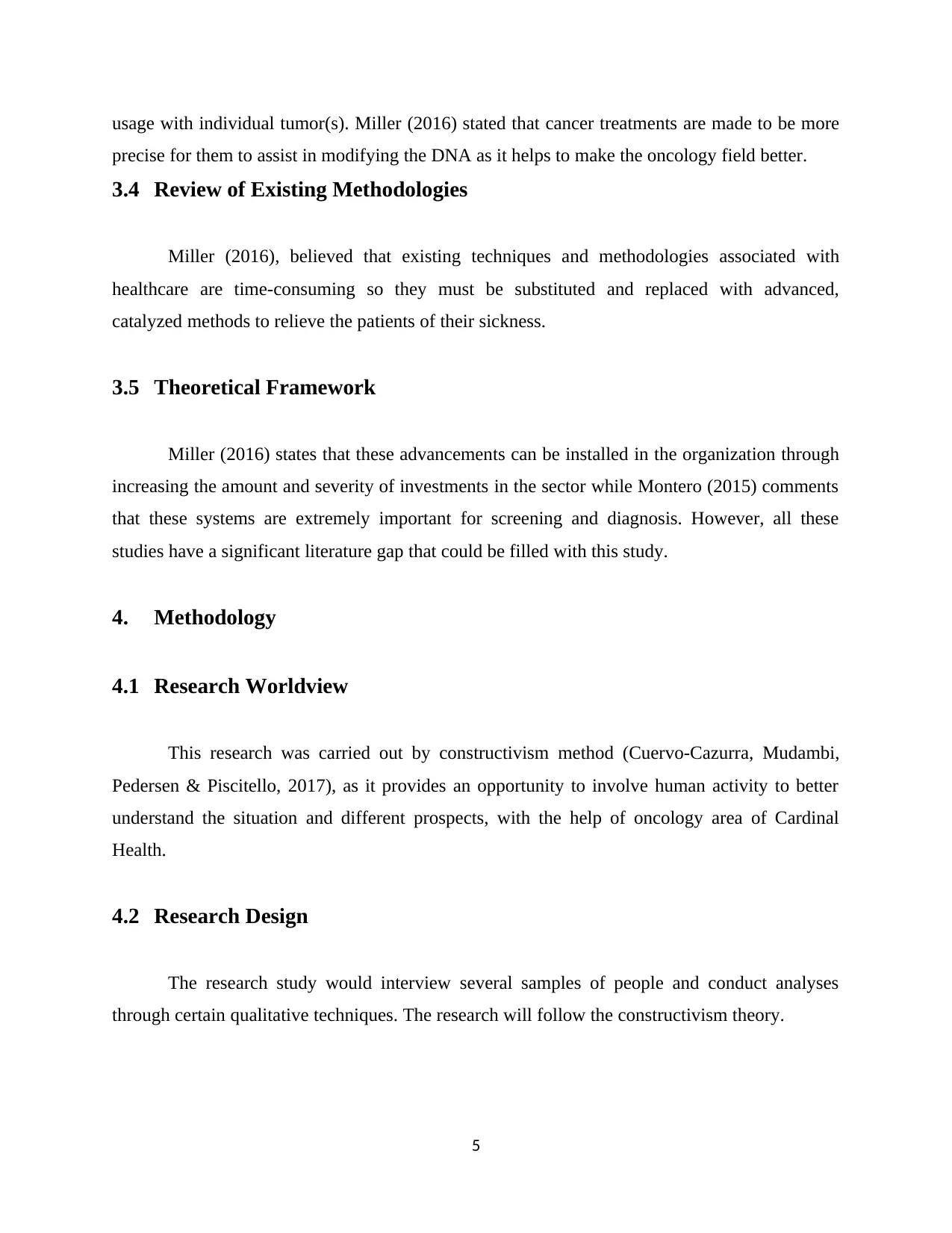
usage with individual tumor(s). Miller (2016) stated that cancer treatments are made to be more
precise for them to assist in modifying the DNA as it helps to make the oncology field better.
3.4 Review of Existing Methodologies
Miller (2016), believed that existing techniques and methodologies associated with
healthcare are time-consuming so they must be substituted and replaced with advanced,
catalyzed methods to relieve the patients of their sickness.
3.5 Theoretical Framework
Miller (2016) states that these advancements can be installed in the organization through
increasing the amount and severity of investments in the sector while Montero (2015) comments
that these systems are extremely important for screening and diagnosis. However, all these
studies have a significant literature gap that could be filled with this study.
4. Methodology
4.1 Research Worldview
This research was carried out by constructivism method (Cuervo-Cazurra, Mudambi,
Pedersen & Piscitello, 2017), as it provides an opportunity to involve human activity to better
understand the situation and different prospects, with the help of oncology area of Cardinal
Health.
4.2 Research Design
The research study would interview several samples of people and conduct analyses
through certain qualitative techniques. The research will follow the constructivism theory.
5
precise for them to assist in modifying the DNA as it helps to make the oncology field better.
3.4 Review of Existing Methodologies
Miller (2016), believed that existing techniques and methodologies associated with
healthcare are time-consuming so they must be substituted and replaced with advanced,
catalyzed methods to relieve the patients of their sickness.
3.5 Theoretical Framework
Miller (2016) states that these advancements can be installed in the organization through
increasing the amount and severity of investments in the sector while Montero (2015) comments
that these systems are extremely important for screening and diagnosis. However, all these
studies have a significant literature gap that could be filled with this study.
4. Methodology
4.1 Research Worldview
This research was carried out by constructivism method (Cuervo-Cazurra, Mudambi,
Pedersen & Piscitello, 2017), as it provides an opportunity to involve human activity to better
understand the situation and different prospects, with the help of oncology area of Cardinal
Health.
4.2 Research Design
The research study would interview several samples of people and conduct analyses
through certain qualitative techniques. The research will follow the constructivism theory.
5
⊘ This is a preview!⊘
Do you want full access?
Subscribe today to unlock all pages.

Trusted by 1+ million students worldwide
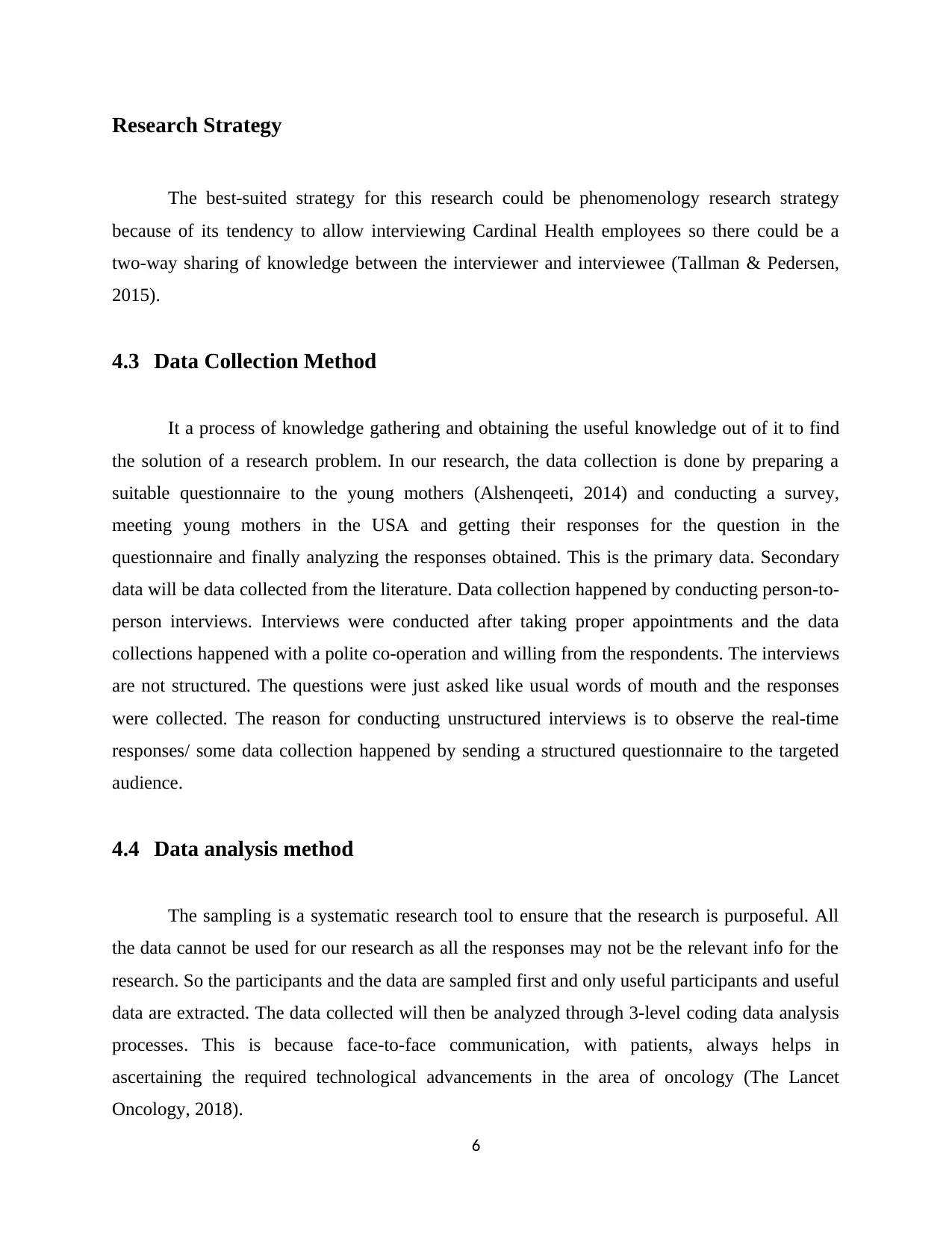
Research Strategy
The best-suited strategy for this research could be phenomenology research strategy
because of its tendency to allow interviewing Cardinal Health employees so there could be a
two-way sharing of knowledge between the interviewer and interviewee (Tallman & Pedersen,
2015).
4.3 Data Collection Method
It a process of knowledge gathering and obtaining the useful knowledge out of it to find
the solution of a research problem. In our research, the data collection is done by preparing a
suitable questionnaire to the young mothers (Alshenqeeti, 2014) and conducting a survey,
meeting young mothers in the USA and getting their responses for the question in the
questionnaire and finally analyzing the responses obtained. This is the primary data. Secondary
data will be data collected from the literature. Data collection happened by conducting person-to-
person interviews. Interviews were conducted after taking proper appointments and the data
collections happened with a polite co-operation and willing from the respondents. The interviews
are not structured. The questions were just asked like usual words of mouth and the responses
were collected. The reason for conducting unstructured interviews is to observe the real-time
responses/ some data collection happened by sending a structured questionnaire to the targeted
audience.
4.4 Data analysis method
The sampling is a systematic research tool to ensure that the research is purposeful. All
the data cannot be used for our research as all the responses may not be the relevant info for the
research. So the participants and the data are sampled first and only useful participants and useful
data are extracted. The data collected will then be analyzed through 3-level coding data analysis
processes. This is because face-to-face communication, with patients, always helps in
ascertaining the required technological advancements in the area of oncology (The Lancet
Oncology, 2018).
6
The best-suited strategy for this research could be phenomenology research strategy
because of its tendency to allow interviewing Cardinal Health employees so there could be a
two-way sharing of knowledge between the interviewer and interviewee (Tallman & Pedersen,
2015).
4.3 Data Collection Method
It a process of knowledge gathering and obtaining the useful knowledge out of it to find
the solution of a research problem. In our research, the data collection is done by preparing a
suitable questionnaire to the young mothers (Alshenqeeti, 2014) and conducting a survey,
meeting young mothers in the USA and getting their responses for the question in the
questionnaire and finally analyzing the responses obtained. This is the primary data. Secondary
data will be data collected from the literature. Data collection happened by conducting person-to-
person interviews. Interviews were conducted after taking proper appointments and the data
collections happened with a polite co-operation and willing from the respondents. The interviews
are not structured. The questions were just asked like usual words of mouth and the responses
were collected. The reason for conducting unstructured interviews is to observe the real-time
responses/ some data collection happened by sending a structured questionnaire to the targeted
audience.
4.4 Data analysis method
The sampling is a systematic research tool to ensure that the research is purposeful. All
the data cannot be used for our research as all the responses may not be the relevant info for the
research. So the participants and the data are sampled first and only useful participants and useful
data are extracted. The data collected will then be analyzed through 3-level coding data analysis
processes. This is because face-to-face communication, with patients, always helps in
ascertaining the required technological advancements in the area of oncology (The Lancet
Oncology, 2018).
6
Paraphrase This Document
Need a fresh take? Get an instant paraphrase of this document with our AI Paraphraser
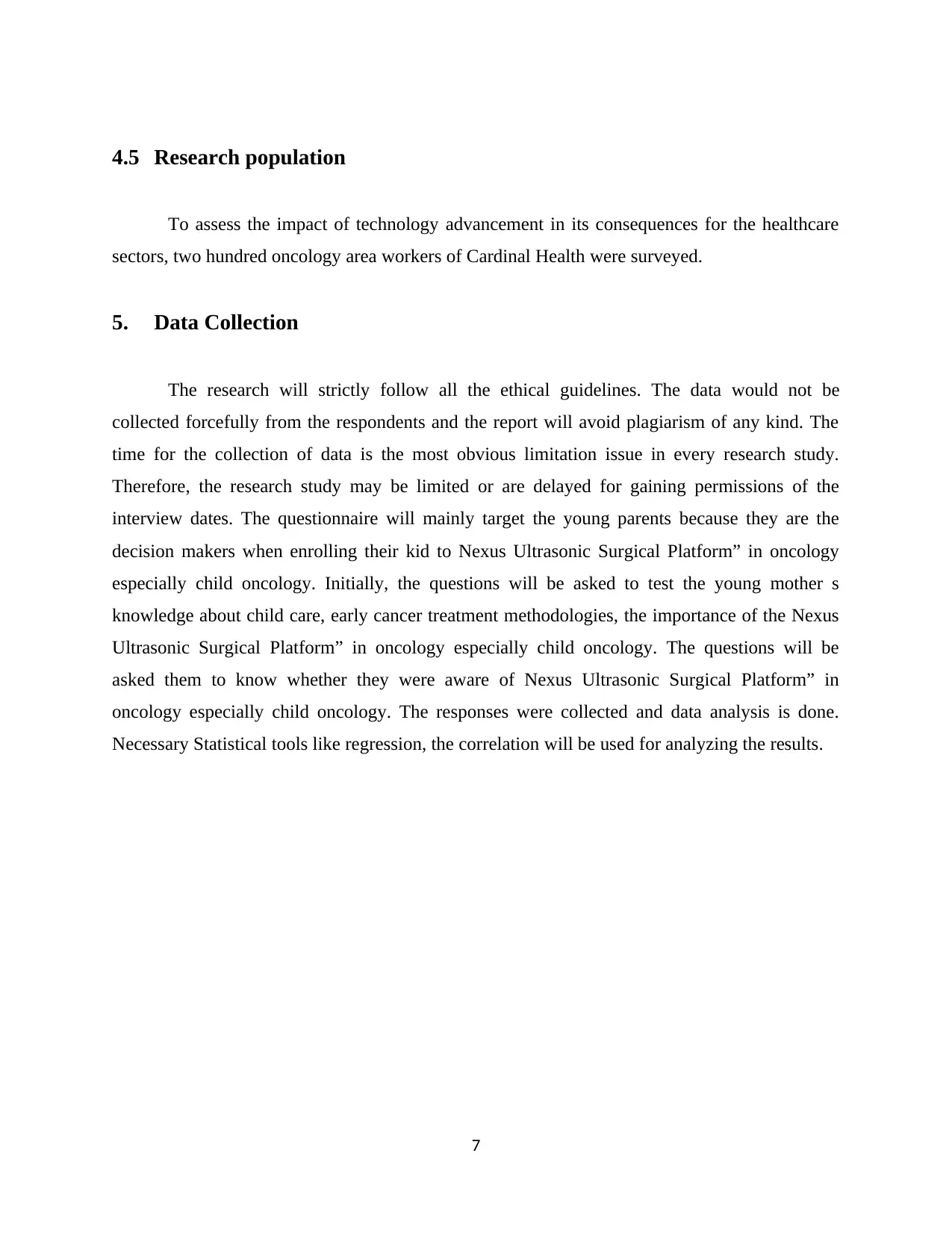
4.5 Research population
To assess the impact of technology advancement in its consequences for the healthcare
sectors, two hundred oncology area workers of Cardinal Health were surveyed.
5. Data Collection
The research will strictly follow all the ethical guidelines. The data would not be
collected forcefully from the respondents and the report will avoid plagiarism of any kind. The
time for the collection of data is the most obvious limitation issue in every research study.
Therefore, the research study may be limited or are delayed for gaining permissions of the
interview dates. The questionnaire will mainly target the young parents because they are the
decision makers when enrolling their kid to Nexus Ultrasonic Surgical Platform” in oncology
especially child oncology. Initially, the questions will be asked to test the young mother s
knowledge about child care, early cancer treatment methodologies, the importance of the Nexus
Ultrasonic Surgical Platform” in oncology especially child oncology. The questions will be
asked them to know whether they were aware of Nexus Ultrasonic Surgical Platform” in
oncology especially child oncology. The responses were collected and data analysis is done.
Necessary Statistical tools like regression, the correlation will be used for analyzing the results.
7
To assess the impact of technology advancement in its consequences for the healthcare
sectors, two hundred oncology area workers of Cardinal Health were surveyed.
5. Data Collection
The research will strictly follow all the ethical guidelines. The data would not be
collected forcefully from the respondents and the report will avoid plagiarism of any kind. The
time for the collection of data is the most obvious limitation issue in every research study.
Therefore, the research study may be limited or are delayed for gaining permissions of the
interview dates. The questionnaire will mainly target the young parents because they are the
decision makers when enrolling their kid to Nexus Ultrasonic Surgical Platform” in oncology
especially child oncology. Initially, the questions will be asked to test the young mother s
knowledge about child care, early cancer treatment methodologies, the importance of the Nexus
Ultrasonic Surgical Platform” in oncology especially child oncology. The questions will be
asked them to know whether they were aware of Nexus Ultrasonic Surgical Platform” in
oncology especially child oncology. The responses were collected and data analysis is done.
Necessary Statistical tools like regression, the correlation will be used for analyzing the results.
7
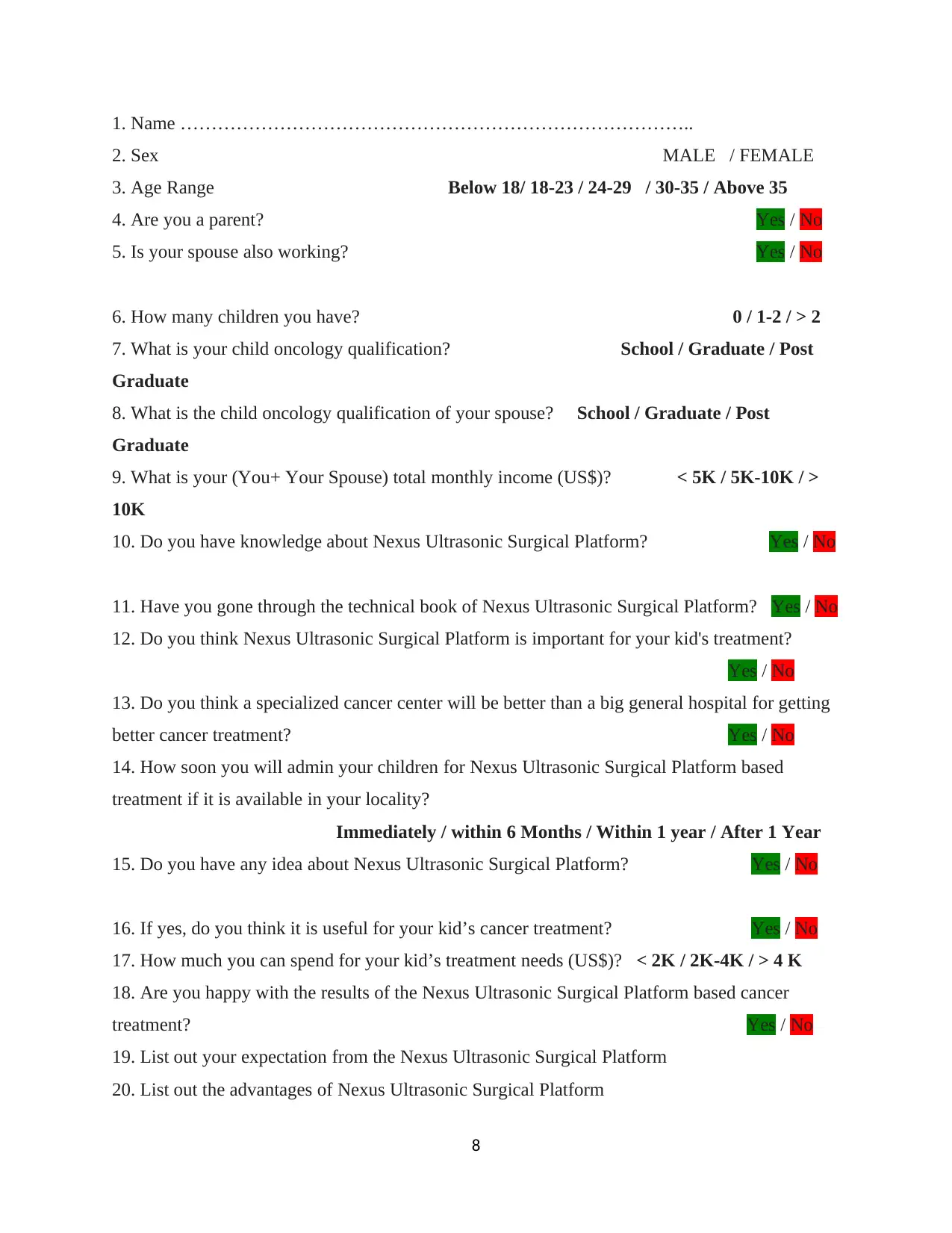
1. Name ………………………………………………………………………..
2. Sex MALE / FEMALE
3. Age Range Below 18/ 18-23 / 24-29 / 30-35 / Above 35
4. Are you a parent? Yes / No
5. Is your spouse also working? Yes / No
6. How many children you have? 0 / 1-2 / > 2
7. What is your child oncology qualification? School / Graduate / Post
Graduate
8. What is the child oncology qualification of your spouse? School / Graduate / Post
Graduate
9. What is your (You+ Your Spouse) total monthly income (US$)? < 5K / 5K-10K / >
10K
10. Do you have knowledge about Nexus Ultrasonic Surgical Platform? Yes / No
11. Have you gone through the technical book of Nexus Ultrasonic Surgical Platform? Yes / No
12. Do you think Nexus Ultrasonic Surgical Platform is important for your kid's treatment?
Yes / No
13. Do you think a specialized cancer center will be better than a big general hospital for getting
better cancer treatment? Yes / No
14. How soon you will admin your children for Nexus Ultrasonic Surgical Platform based
treatment if it is available in your locality?
Immediately / within 6 Months / Within 1 year / After 1 Year
15. Do you have any idea about Nexus Ultrasonic Surgical Platform? Yes / No
16. If yes, do you think it is useful for your kid’s cancer treatment? Yes / No
17. How much you can spend for your kid’s treatment needs (US$)? < 2K / 2K-4K / > 4 K
18. Are you happy with the results of the Nexus Ultrasonic Surgical Platform based cancer
treatment? Yes / No
19. List out your expectation from the Nexus Ultrasonic Surgical Platform
20. List out the advantages of Nexus Ultrasonic Surgical Platform
8
2. Sex MALE / FEMALE
3. Age Range Below 18/ 18-23 / 24-29 / 30-35 / Above 35
4. Are you a parent? Yes / No
5. Is your spouse also working? Yes / No
6. How many children you have? 0 / 1-2 / > 2
7. What is your child oncology qualification? School / Graduate / Post
Graduate
8. What is the child oncology qualification of your spouse? School / Graduate / Post
Graduate
9. What is your (You+ Your Spouse) total monthly income (US$)? < 5K / 5K-10K / >
10K
10. Do you have knowledge about Nexus Ultrasonic Surgical Platform? Yes / No
11. Have you gone through the technical book of Nexus Ultrasonic Surgical Platform? Yes / No
12. Do you think Nexus Ultrasonic Surgical Platform is important for your kid's treatment?
Yes / No
13. Do you think a specialized cancer center will be better than a big general hospital for getting
better cancer treatment? Yes / No
14. How soon you will admin your children for Nexus Ultrasonic Surgical Platform based
treatment if it is available in your locality?
Immediately / within 6 Months / Within 1 year / After 1 Year
15. Do you have any idea about Nexus Ultrasonic Surgical Platform? Yes / No
16. If yes, do you think it is useful for your kid’s cancer treatment? Yes / No
17. How much you can spend for your kid’s treatment needs (US$)? < 2K / 2K-4K / > 4 K
18. Are you happy with the results of the Nexus Ultrasonic Surgical Platform based cancer
treatment? Yes / No
19. List out your expectation from the Nexus Ultrasonic Surgical Platform
20. List out the advantages of Nexus Ultrasonic Surgical Platform
8
⊘ This is a preview!⊘
Do you want full access?
Subscribe today to unlock all pages.

Trusted by 1+ million students worldwide
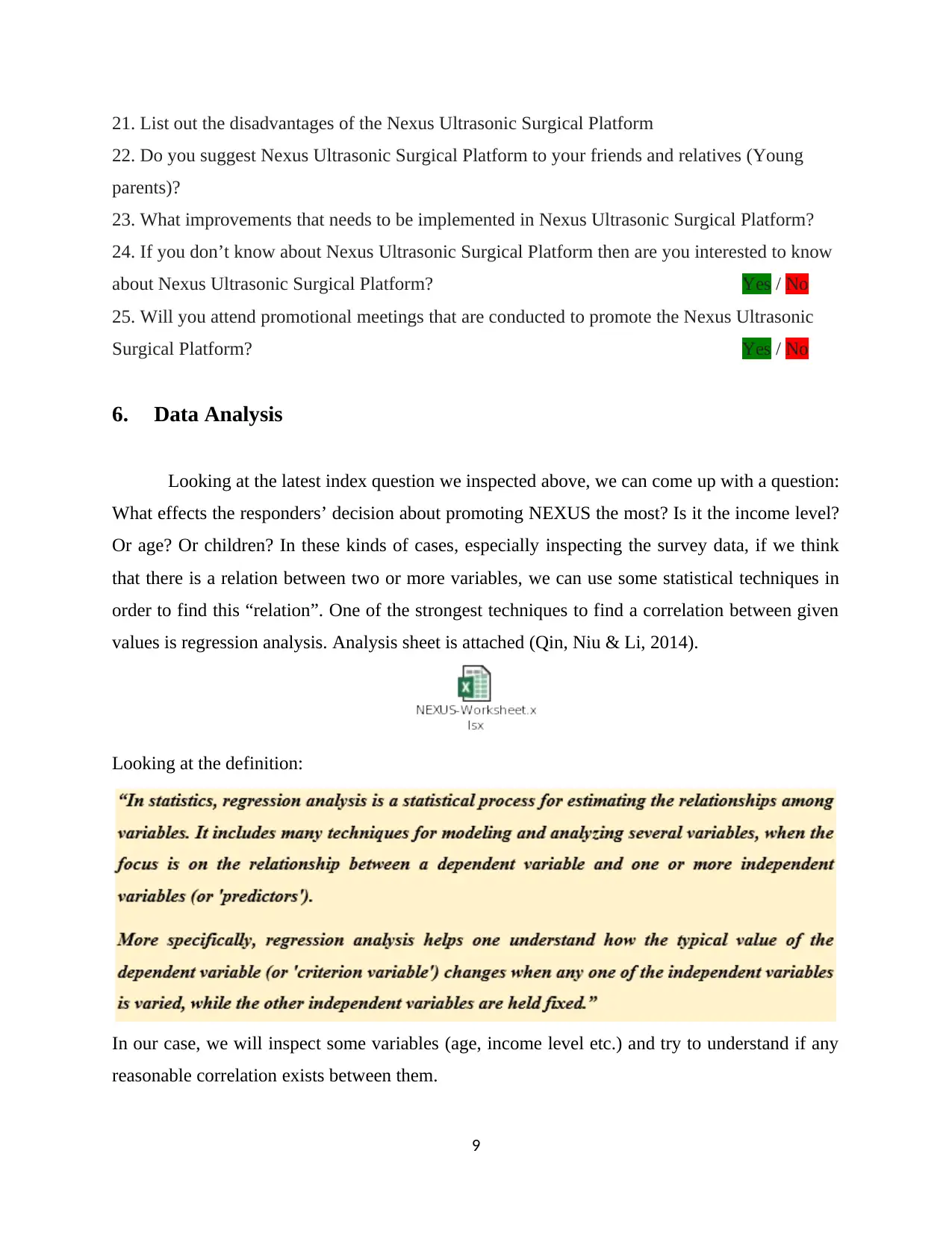
21. List out the disadvantages of the Nexus Ultrasonic Surgical Platform
22. Do you suggest Nexus Ultrasonic Surgical Platform to your friends and relatives (Young
parents)?
23. What improvements that needs to be implemented in Nexus Ultrasonic Surgical Platform?
24. If you don’t know about Nexus Ultrasonic Surgical Platform then are you interested to know
about Nexus Ultrasonic Surgical Platform? Yes / No
25. Will you attend promotional meetings that are conducted to promote the Nexus Ultrasonic
Surgical Platform? Yes / No
6. Data Analysis
Looking at the latest index question we inspected above, we can come up with a question:
What effects the responders’ decision about promoting NEXUS the most? Is it the income level?
Or age? Or children? In these kinds of cases, especially inspecting the survey data, if we think
that there is a relation between two or more variables, we can use some statistical techniques in
order to find this “relation”. One of the strongest techniques to find a correlation between given
values is regression analysis. Analysis sheet is attached (Qin, Niu & Li, 2014).
Looking at the definition:
In our case, we will inspect some variables (age, income level etc.) and try to understand if any
reasonable correlation exists between them.
9
22. Do you suggest Nexus Ultrasonic Surgical Platform to your friends and relatives (Young
parents)?
23. What improvements that needs to be implemented in Nexus Ultrasonic Surgical Platform?
24. If you don’t know about Nexus Ultrasonic Surgical Platform then are you interested to know
about Nexus Ultrasonic Surgical Platform? Yes / No
25. Will you attend promotional meetings that are conducted to promote the Nexus Ultrasonic
Surgical Platform? Yes / No
6. Data Analysis
Looking at the latest index question we inspected above, we can come up with a question:
What effects the responders’ decision about promoting NEXUS the most? Is it the income level?
Or age? Or children? In these kinds of cases, especially inspecting the survey data, if we think
that there is a relation between two or more variables, we can use some statistical techniques in
order to find this “relation”. One of the strongest techniques to find a correlation between given
values is regression analysis. Analysis sheet is attached (Qin, Niu & Li, 2014).
Looking at the definition:
In our case, we will inspect some variables (age, income level etc.) and try to understand if any
reasonable correlation exists between them.
9
Paraphrase This Document
Need a fresh take? Get an instant paraphrase of this document with our AI Paraphraser
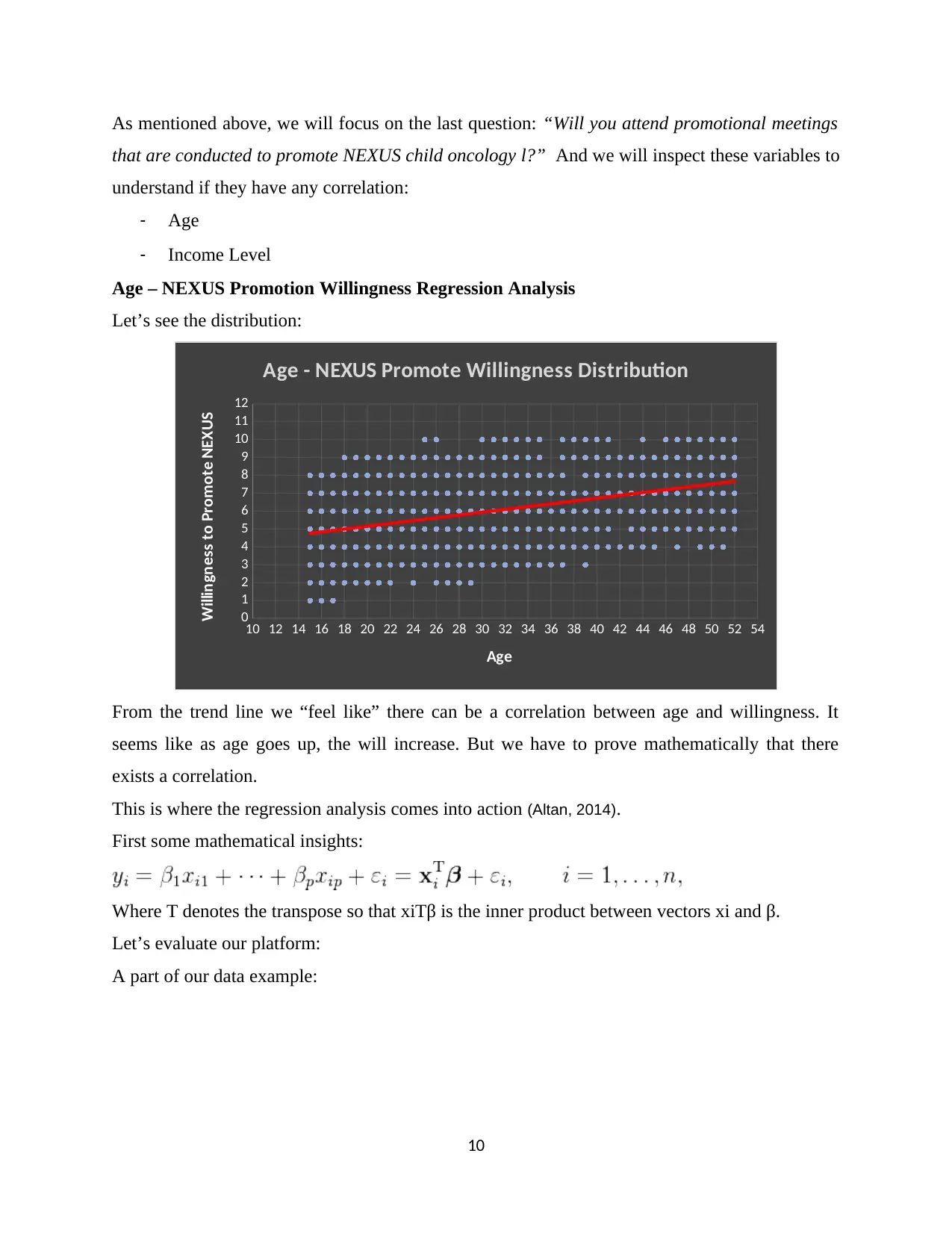
As mentioned above, we will focus on the last question: “Will you attend promotional meetings
that are conducted to promote NEXUS child oncology l?” And we will inspect these variables to
understand if they have any correlation:
- Age
- Income Level
Age – NEXUS Promotion Willingness Regression Analysis
Let’s see the distribution:
10 12 14 16 18 20 22 24 26 28 30 32 34 36 38 40 42 44 46 48 50 52 54
0
1
2
3
4
5
6
7
8
9
10
11
12
Age - NEXUS Promote Willingness Distribution
Age
Willingness to Promote NEXUS
From the trend line we “feel like” there can be a correlation between age and willingness. It
seems like as age goes up, the will increase. But we have to prove mathematically that there
exists a correlation.
This is where the regression analysis comes into action (Altan, 2014).
First some mathematical insights:
Where T denotes the transpose so that xiTβ is the inner product between vectors xi and β.
Let’s evaluate our platform:
A part of our data example:
10
that are conducted to promote NEXUS child oncology l?” And we will inspect these variables to
understand if they have any correlation:
- Age
- Income Level
Age – NEXUS Promotion Willingness Regression Analysis
Let’s see the distribution:
10 12 14 16 18 20 22 24 26 28 30 32 34 36 38 40 42 44 46 48 50 52 54
0
1
2
3
4
5
6
7
8
9
10
11
12
Age - NEXUS Promote Willingness Distribution
Age
Willingness to Promote NEXUS
From the trend line we “feel like” there can be a correlation between age and willingness. It
seems like as age goes up, the will increase. But we have to prove mathematically that there
exists a correlation.
This is where the regression analysis comes into action (Altan, 2014).
First some mathematical insights:
Where T denotes the transpose so that xiTβ is the inner product between vectors xi and β.
Let’s evaluate our platform:
A part of our data example:
10
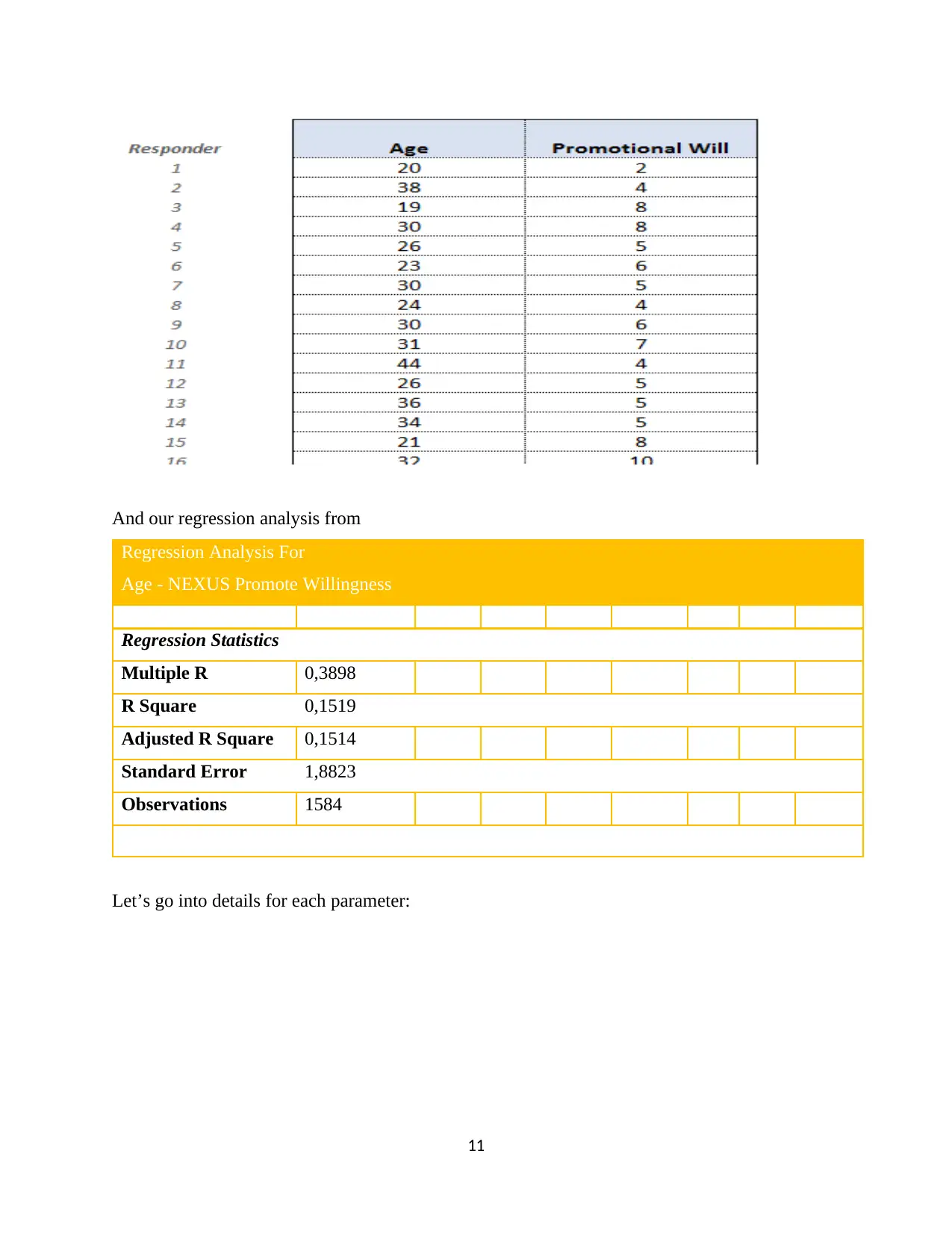
And our regression analysis from
Regression Analysis For
Age - NEXUS Promote Willingness
Regression Statistics
Multiple R 0,3898
R Square 0,1519
Adjusted R Square 0,1514
Standard Error 1,8823
Observations 1584
Let’s go into details for each parameter:
11
Regression Analysis For
Age - NEXUS Promote Willingness
Regression Statistics
Multiple R 0,3898
R Square 0,1519
Adjusted R Square 0,1514
Standard Error 1,8823
Observations 1584
Let’s go into details for each parameter:
11
⊘ This is a preview!⊘
Do you want full access?
Subscribe today to unlock all pages.

Trusted by 1+ million students worldwide
1 out of 20
Related Documents
Your All-in-One AI-Powered Toolkit for Academic Success.
+13062052269
info@desklib.com
Available 24*7 on WhatsApp / Email
![[object Object]](/_next/static/media/star-bottom.7253800d.svg)
Unlock your academic potential
Copyright © 2020–2025 A2Z Services. All Rights Reserved. Developed and managed by ZUCOL.





